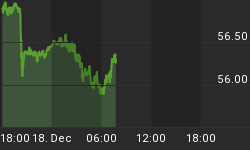This is the first part of a two part series on the forces driving the gold price now. The second part is in the present issue of the Gold Forecaster.
We were right in believing that the € and gold will and are de-coupling. But far more than that is happening in the gold markets of the world. But the process is an ebb and flow process, with this week seeing gold move with the € and last week moving independently of both. What is becoming clearer and clearer to investors is the gold price should not move with the € or with any other currency, as there are few common denominators between gold and currencies. The erosion of confidence in currencies is far more pertinent to the gold price. Along that line of thought a look over the last year and more is relevant to the future of gold.
For over a year now, the gold price has been consolidating from above $1,200 down to $1,050, with the point of the pennant being $1,150 ±. While the gold price has been reacting to the € moves against the U.S. $, and in the opposite direction to the $, during that time, just below the surface and right down to the very structure of the monetary world, something different has been going on. The words 'decaying confidence' seems too vague to describe it. To isolate one particular potential crisis does not do it justice either.

What is happening is similar in concept to when tributaries of a river meet the main stream and the flow becomes overwhelming. Follow the thinking of the saying, "He who sows the wind reaps the whirlwind" and you start to get the feel of where we are going with this. It has been of significant concern that the time the gold price has been moving between $1,075 and $1,150 has been so extended. Normally a consolidation period is over far quicker and there has been fairly strong moves thereafter. The Gold Forecaster called the bottom at $1,050 and emphasized this in subsequent Market Alerts in the last few months. However, as the consolidation dragged on it became clear that something far larger than a simple consolidation was underway. We are not talking about a mid-trend correction either. It is far more than that!
Falling confidence in the Monetary system itself.
Not only have banks lost their untouchable image and their position on the moral high ground, but during the last year there has been a marked change in the perception investors have of the global monetary system itself. Confidence has dropped heavily in the €, in Pound Sterling and in the U.S. $. Major surplus holders have expressed themselves strongly that they are unhappy with the state of U.S. financing, both internally and externally. Then the Eurozone lost its solid image.
Confidence in Sterling has dropped markedly as the prospect of an indecisive potentially 'hung' Parliament looms. The € has taken a caning because of the one very visible problem of Greece and potentially Spain Portugal, et al. The Yen remains unattractive at close to its peak, with its nearly zero interest rates. These four currencies make up the Special Drawing Right of the International Monetary Fund, which is a reflection of the world's main currencies.
Not reflected in Exchange Rates
There is hardly any way in which this falling confidence can be reflected in the currency world as they all fall together and look relatively stable against each other. But you can be sure that surplus holders and outside investors are not buying into any idea of the system being stable. In this very divided world, decaying confidence will be expressed but how will it be expressed? We are sure that no matter how, gold buying will be one way.

Now the structural damage will extend and involve not just banks and credit but include the appearance of Capital Controls [now 'approved' by the I.M.F.], tensions growing between the West and East [don't expect a revaluation of the Yuan anytime soon] even leading to a fragmentation of international trade relations, following a bout of protectionism. The Eurozone's problems are moving to become the world's. The difference is that there is no Maastricht Treaty governing the global currency systems. A global solution to the global monetary system must be found, if it is to remain intact.
U.S. Treasury Yields & Investment demand for gold
How close are we to such multiple crises? Previously, we discussed the concept of 10-year Treasury yields rising as a thermometer to what lies ahead. Greenspan has labelled this the "canary in the mine". Right now long-term Treasury yields are rising strongly steepening the Yield Curve. In the climate we have described above, this is bad news. As they rise, they tell us to expect more of Treasuries [Yield] because of future rising risks [we don't even dignify the concept that this is a growth signal]. Such yield elevation points to international disenchantment with the prospects for $ investments.
In this scene gold will be viewed as a 'retreat position' in the face of considerable uncertainty. These Treasury Yields Curves are a measure of where the gold price is going, indirectly. But this time we are not talking of a growth in the gold price as we have seen in the last ten years, but a strong move from the largest of institutions into gold.
Where will the gold price go in 2010?
Subscribers only
Gold Forecaster regularly covers all fundamental and Technical aspects of the gold price in the weekly newsletter. To subscribe, please visit www.GoldForecaster.com.















